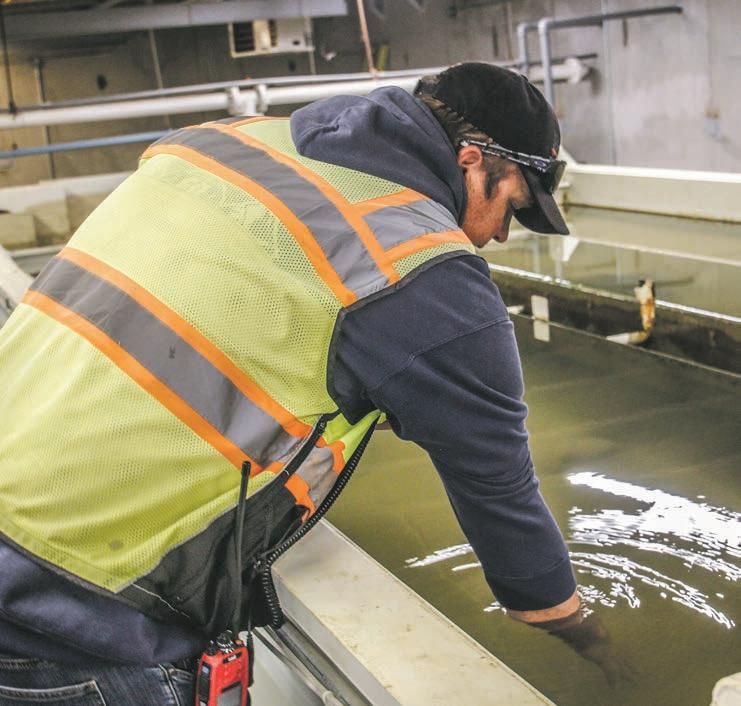
4 minute read
NOT SO PASTORAL
May summit in the Roundhouse will spotlight host of challenges tugging at New Mexico’s rural communities
BY WILLIAM MELHADO william@sfreporter.com
Advertisement
SPRINGER—When Boe Lopez isn’t busy searching for solutions to a housing crisis as mayor of this small town of just over 1,000 residents near the Texas Panhandle, he’s working as a cattle rancher and an extension agent for New Mexico State University.
Lopez, like many in Springer, wears a lot of hats. That sort of juggling act spotlights the challenges facing many of the state’s rural communities—including aging infrastructure and a lack of transportation options—which are magnified by a lack of resources both financial and human.
Lopez tells SFR he wants to grow his hometown, yet another pressure in a long list of community demands.
Rural residents hope to gain legislators’ attention for more support of their often overlooked communities during a two-day summit planned for May 12 and 13 at the Roundhouse. Leaders from across the state and Washington, DC will gather to discuss the challenges rural parts of the state face, ranging from health care to infrastructure, with the goal of hammering out some solutions.
“We don’t have mental health services, we need drug rehabilitation, we need activities for our youth, we need services for our seniors, we are trying to introduce public transportation,” says Veronica Serna, chair of the Mora County Commission. (And that was before a massive wildfire destroyed homes in her county and was still burning at presstime.)
The list goes on, she says, and the common denominator is a lack of funding.
Serna’s community relies on grants from the state and federal governments. But finding and applying for those grants requires personnel that Mora County doesn’t have.
It’s the same for Lopez in Springer, he says.
“The other hindrance sometimes is, you go and get the funds that we need to do the project, but then you have to have the capacity within an employee or employees to be able to administer the grant, to do the reporting that [is] required by the grant,” he says.
In Springer, the town has made significant investments in wastewater treatment facilities, improvements to the airport and cleaning up derelict buildings downtown. It took three different funding sources to secure the $5.5 million wastewater renovations, which are slated for completion this summer.
Craig Eppler, Springer’s field supervisor, tells SFR the project doesn’t feature fancy upgrades. Instead, it’s aimed at avoiding a catastrophe.
The aging facility was “stripped down to the bone and redone,” Eppler says. The work included installing new sewer lagoons, security fencing and a UV treatment system.
The treatment site sits about a mile away from the Cimarron River, Eppler says. If a leak occurred it would contaminate the water source and cost millions to clean up.
The town also needs cash to maintain basic services such as the Springer
WILLIAM MELHADO
Craig Eppler reaches into one of the settling tanks at Springer’s water treatment facility, which provides service to the town’s residents and the surrounding community, including the women’s prison.
Correctional Center, which can hold up to 400 women at one time, and to develop and expand, Lopez says.
There has been progress. Lopez notes an increase in air traffic, primarily from ranchers and hunters, that came after improvements to the airport.
Lopez and Serna point to a lack of law enforcement and emergency services personnel as a common challenge.
Lopez says it’s been difficult to keep officers in the community. “They would use these rural communities to get their certifications and then they leave us.”
So Springer tried crafting a contract that required officers to stay at least two years if the town paid for their training and certification, but that didn’t “hold water in court,” says Lopez. “You can’t force someone to stay.”
The town switched to incentives in an effort to keep officers. But that wouldn’t work for the fire department and EMS because volunteers staff both those departments in Springer.
As state Rep. Roger Montoya, D-Velarde, spoke with constituents, he heard more and more about issues like the ones in Springer and Mora County, he tells SFR. His expansive district covers mostly rural areas of Northern New Mexico, including Rio Arriba, Colfax, Mora and San Miguel counties. So he wanted to give rural residents a forum.
Montoya and other elected state leaders will convene next month at the Capitol to “hold space” for rural community advocates to weigh in on their most pressing concerns and help develop legislation to address them. Xochitl Torres Small, the US Department of Agriculture’s undersecretary for rural development, will deliver the keynote speech.
The summit’s timing is critical, Montoya says. With funding from the federal Infrastructure Investment and Jobs Act available through grants in the coming months, local governments need support to apply.
Lopez looks forward to the opportunity to speak with other rural leaders, “just to hear some of the things they’re doing and how they’ve gotten creative with getting funding for their projects.”








